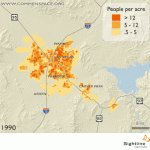Search Results
-
The Price of the Next Trip
Gasoline prices are at their highest in recent memory and they appear likely to stay high for months. Is this a dream come true for climate defenders and transportation reformers? Far from it. Short-term price spikes, such as the one we’re enduring now, have surprisingly little impact on driver behavior. But they constitute a massive drain on the economies of fuel-importing regions such as ours. And they enrich oil companies,...Read more » -
We Are Multi-Family
BC continues to rack up impressive numbers in smart growth: its booming home-construction economy is producing three times as much multifamily housing as detached, single-family housing. Construction of multi-family housing in greater Vancouver reached an all-time high of some 1,900 apartments, condominiums, and townhouses in April. Construction of detached, single-family houses trailed at under 600 units. The largest increases were in the city of Vancouver and in neighboring Burnaby, while...Read more » -
Getting railroaded II
Christopher Arkills, a key aide to King County Councilman Dwight Pelz wrote a rejoinder to my post on rail. His critique and my full response are here. But here’s the crux: Christopher: You build mass transit, not to get folks out of their cars today, but to influence land use patterns over the next 20, 30, 50 years. . . . You tout BRT [bus-rapid transit], HOV, vanpools, and carpools...Read more » -
Then and Now
Further to yesterday’s post: To understand how much Vancouver’s downtown has grown as a residential neighborhood, look at the before-and-after panoramas on this page. Anyone know of similar photos of other Cascadian cities and towns? 5/3 Update: Rachel Severson sent in this link for a downtown Seattle comparison. It shows 1907 (!) and 2002.Read more » -
The Condo Gap
In the bid to create walkable, exciting, live-work-play downtowns, Vancouver’s enormous lead over Seattle and Portland just keeps growing. New developments in the heart of Vancouver – which already has four times as many residents as the geographically larger downtown of Seattle – continue to sprout at a phenomenal rate. The city core has added between 1,500 and 2,500 new housing units each year for the last decade, with 3,000...Read more » -
Go Tell Anti-Roadie
(This post is part of a series.) It appears that a growing number of Seattle residents are questioning whether the Alaskan Way Viaduct—the elevated highway that hugs the Seattle waterfront through downtown—ought to be torn down and replaced with…well…nothing at all. There has been a lot written about this in the past few years—especially recently. This is not nearly as radical an idea as it might seem. Portland removed a...Read more » -
Ada Boy!
The governments in and around Boise, Idaho, are finally making some progress on planning for smart growth. They’ve agreed to a process to create a single growth blueprint. It’s a welcome step for the metropolitan area that has earned the dubious distinction of most sprawling in Cascadia.Read more » -
Are you dense?
John Holtzclaw, a transportation researcher from the Bay Area of California, has an interesting website that shows the relationships between residential density and driving. It includes photos of different San Francisco neighborhoods and data on their density, fuel use, and air pollution rates. One point: high density doesn’t necessarily mean high rise. You can also use his calculator to check your own neighborhood’s (projected) fuel consumption. But you’ll have to...Read more » -
Hybrid Vigor?
Although hybrid gas-electric vehicles—including the Toyota Prius and the Honda Insight and a version of the Civic—are certainly becoming more common, they’re still a rarity on the roads: in 2003 there were less than 44,000 registered in the entire U.S. By contrast, there are about 230,000,000 non-hybrid cars and trucks in the US. Virginia and Maryland have the most hybrid cars per capita—with 4.5 and 3.4 hybrid vehicles for every...Read more » -
Population Density in Las Vegas, NV
Of the 12 non-Cascadian cities studied by Sightline, greater Las Vegas is the densest, with half of its residents living in compact communities in 2000.Read more »


